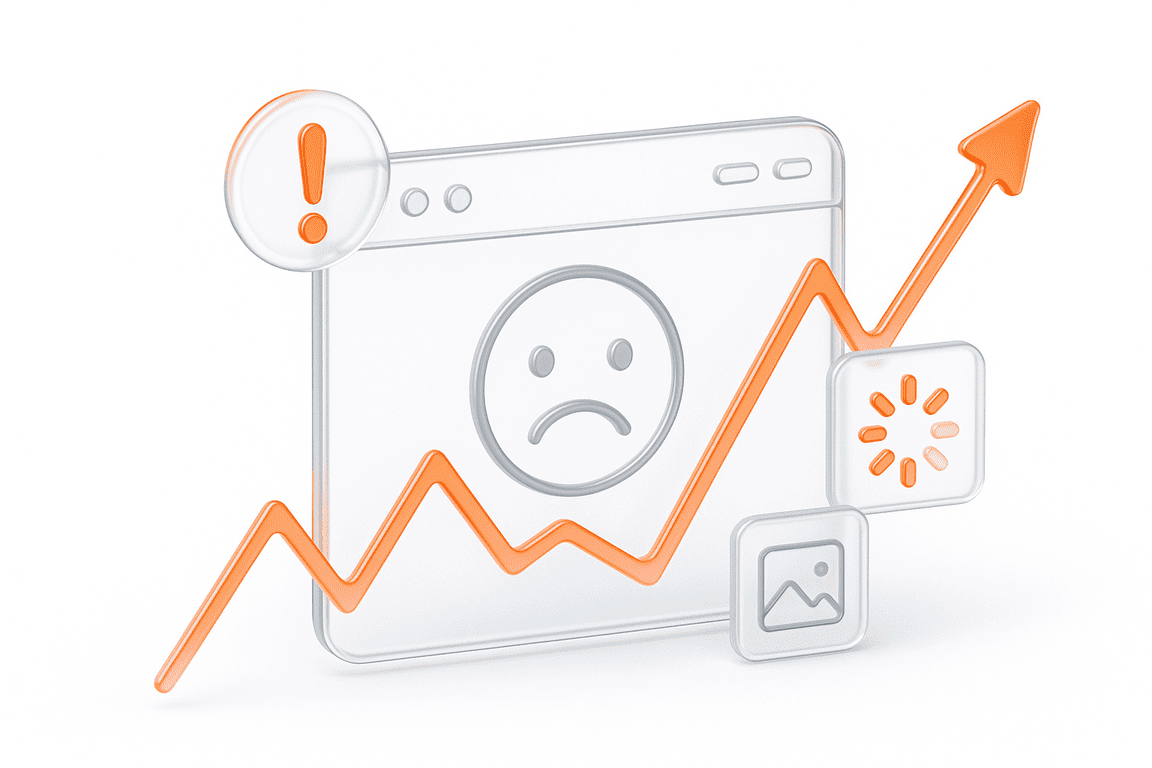Why Your Software Needs a Performance Testing Strategy?
Building software is one thing. Making sure it performs well when real people depend on it is another. An app might look great in development, pass internal reviews, and even impress beta testers, but the real test comes when it faces unpredictable traffic, poor connections, or heavy workloads.
A well-planned performance testing strategy removes the guesswork. By following a clear software performance testing strategy, teams can measure speed, stability, and scalability before problems ever reach end users. The right test strategy for performance testing not only protects the user experience but also helps businesses avoid downtime, lost revenue, and costly fixes after launch.
Define Performance Objectives
A performance testing strategy should always begin with clear, measurable objectives. Without them, testing risks becoming unfocused, wasting time on areas that don’t matter while overlooking the ones that impact users most. Defined goals not only guide the test process but also connect results to real business outcomes like customer satisfaction, operational efficiency, and revenue protection.
Here’s how to set strong performance objectives for your software performance testing strategy:
1. Establish Key Performance Metrics
Metrics are the foundation of every test. They tell you whether your system is fast enough, stable enough, and efficient enough for real-world use. Common performance test metrics include:
2. Build Effective Test Cases
Once metrics are defined, design test cases that reflect real usage. A strong test strategy for performance testing should cover multiple dimensions, such as:
3. Analyze and Interpret Results
Numbers alone don’t improve performance. Results need to be analyzed and compared against your objectives. Look for:
4. Connect Objectives to Business Goals
Finally, tie everything back to business outcomes. A software performance testing strategy is not just about technical speed; it’s about enabling growth and protecting reputation. Objectives should answer:
Select the Right Types of Performance Tests
An effective performance testing strategy doesn’t rely on just one method. Different tests uncover different weaknesses, and your software performance testing strategy should combine them based on your business goals, system architecture, and industry needs.
Here are the main types of performance tests to include in your test strategy for performance testing:
Load Testing
Load testing evaluates how your application performs under normal and expected peak conditions. It shows whether response times, resource use, and overall stability remain within acceptable limits when user traffic increases steadily.
Stress Testing
Stress testing pushes your system beyond its normal operating capacity to reveal breaking points. It helps you understand how the system fails, whether it crashes completely or degrades gracefully.
Spike Testing
Unlike stress tests, which increase load gradually, spike testing introduces sudden and extreme surges in traffic. This helps determine how the system reacts to abrupt changes in demand.
Scalability Testing
Scalability testing examines how well the system grows with increasing workloads, data volumes, and users. It provides insight into future capacity planning and infrastructure needs.
Endurance (Soak) Testing
Endurance testing measures how an application performs under a steady load for an extended period. It often exposes issues like memory leaks, database slowdowns, or performance degradation over time.
Volume Testing
Volume testing focuses on how applications handle large amounts of data. It shows whether queries, batch processing, and storage functions remain efficient as datasets grow.
| Test Type | What It Does | Goal | Use Case |
| Load Testing | Checks performance under normal and peak load. | Handle expected workloads smoothly. | E-commerce checkout with 10,000 users. |
| Stress Testing | Pushes system beyond limits. | Find breaking points and recovery paths. | Streaming app with double the viewers. |
| Spike Testing | Adds sudden traffic surges. | Test resilience to abrupt spikes. | Ticketing site at concert launch. |
| Scalability Testing | Measures growth with users and data. | Ensure smooth scaling with demand. | Fintech app facing 10x more transactions. |
| Endurance (Soak) Testing | Runs system under load for long periods. | Check long-term stability and leaks. | ERP system under 72-hour continuous use. |
| Volume Testing | Tests large datasets and storage. | Validate efficiency with heavy data. | Healthcare app searching millions of records. |
Choosing the Right Mix
Not all organizations share the same priorities, which is why a performance testing strategy should never be a one-size-fits-all checklist. Each business faces different risks depending on its industry, system architecture, and customer expectations. The right approach is to select a combination of test types that reflects both your current technical environment and your long-term business goals.
For example, a bank may place more emphasis on endurance testing to guarantee stability during continuous operations, along with volume testing to ensure fast transaction processing across massive datasets. On the other hand, a SaaS startup is likely to prioritize load testing to validate normal usage, stress testing to uncover breaking points, and scalability testing to prepare for rapid customer growth.
The key is to avoid testing in isolation. Instead, think of your software performance testing strategy as a toolkit: different tests work together to give a complete picture of how your system behaves. Aligning these tests with business requirements, like uptime guarantees, compliance regulations, or seasonal traffic surges, ensures your testing efforts deliver real-world value, not just technical data.
How to Measure Software Performance
Measuring performance is the backbone of any performance testing strategy. Without clear metrics, you can’t tell whether your software is ready for real users or where improvements are needed. The right measurements turn test results into business insights, showing how your application handles speed, stability, and scalability.
Function-Related Metrics
These metrics reflect how useful and effective the application is from a user and business perspective. They help evaluate whether the system delivers consistent functionality under different workloads. Common examples include:
Size-Related Metrics
These metrics evaluate the scale of software outputs and how growth affects performance. They are particularly important for long-term planning and scalability testing. Examples include:
Why These Metrics Matter
Together, function-related and size-related metrics provide a complete picture of software performance. They allow teams to:
When integrated into a software performance testing strategy, these measurements ensure you’re not just testing for the sake of it, you’re testing to deliver reliable results that scale with your users and your business.
Benefits of Working with QA Experts for Stronger Performance Testing Strategies
Creating a reliable application requires more than good code. You need to understand business goals, customer expectations, and technical limitations — and tie them together with a well-defined performance testing strategy. This is where experienced QA experts add real value.
1. Clear Alignment with Business Goals
QA specialists translate business requirements into measurable performance objectives. They ensure that your software performance testing strategy focuses on what matters most — from fast checkout times in retail to guaranteed uptime in finance.
2. Early Detection of Bottlenecks
By embedding QA in the development lifecycle, performance issues are caught early. This prevents costly fixes in production and helps teams build benchmarks for future regression testing.
3. Realistic and Reliable Test Scenarios
QA experts know how to design test cases that mimic real-world usage patterns instead of artificial lab conditions. This leads to more accurate insights about stability, scalability, and resource efficiency.
4. Continuous Improvement
With QA involved, performance testing isn’t a one-time task. Results are analyzed, compared to benchmarks, and fed back into development, creating a cycle of continuous improvement.
5. Stronger Collaboration Across Teams
QAs act as the bridge between developers, testers, and business analysts. Their role ensures that your test strategy for performance testing is both technically sound and business-driven.
Tips to Create Your Performance Testing Strategy
A performance testing strategy works best when it’s built methodically, with input from both technical and business teams. Rushing into testing without preparation often leads to wasted effort or results that don’t reflect real-world conditions. Here are the key steps to follow when creating your software performance testing strategy:
1. Identify the Key Features of Your Application
Not every feature has the same impact on performance. Start by reviewing your application’s traffic analytics and usage patterns. Identify the core functions that are most critical for users, such as login, search, payment, or reporting, and prioritize them for testing.
2. Define Realistic User Loads
Estimate how many users your system will serve at peak times and how their behavior may change over time. Use historical analytics, projected growth, and industry benchmarks to set realistic expectations.
3. Map Out Usage Scenarios
Performance tests should mirror real user behavior, not just artificial scripts. Create scenarios that reflect how different groups of users interact with your system.
4. Collaborate Across Teams
A test strategy for performance testing isn’t just the responsibility of QA engineers. Developers, architects, business analysts, and operations teams should all contribute. Cross-team collaboration ensures that testing covers both technical requirements and business priorities.
5. Plan for Growth and Change
Applications evolve with new features, integrations, and user bases. Build flexibility into your performance testing strategy so it can adapt to changes without starting from scratch.
Steps of Work that Your Performance Testing Teams Need to Follow
Here is an example of how technical teams should implement a software performance test strategy:
Stage One: Preliminary Planning
Stage Two: Determining Your Current Setup
Stage Three: Metrics
Stage Four: Approaching the Actual Test
What Is Your Business Losing Without Performance Testing?
Skipping a test strategy for performance testing comes with serious risks. Without it, your business cannot accurately identify performance issues or prepare applications for real-world user loads. Problems that go unnoticed during development often surface in production, leading to:
On the other hand, implementing a structured software performance testing strategy significantly improves application quality from the earliest stages of development. It helps ensure your system is reliable, scalable, and cost-efficient before customers ever touch it.
If your team struggles to pinpoint bottlenecks or set up an effective test strategy for performance testing, it’s time to bring in experienced professionals who can guide you through the process.
Consider PFLB Your Best Performance Testing Provider
Choosing the right partner for performance testing can make the difference between a smooth product launch and costly production failures. At PFLB, we’ve specialized in performance engineering since 2008, helping businesses across industries ensure their systems remain fast, stable, and scalable under any conditions.
Why PFLB?
Success Stories
Partner With Us
With PFLB as your provider, you gain more than testing; you gain a partner committed to your long-term success.
Contact us today to discuss your project and build a performance testing strategy that ensures speed, scalability, and reliability from day one.
Related insights in blog articles
How Website Performance Impacts E-Commerce Sales and Cart Abandonment

Every e-commerce store has mere milliseconds to make the right impression on shoppers. When prospects land on a product page, they assess every single metric, and e-commerce website performance and speed are the most critical ones. In most scenarios, impatient users will bounce instantly — at the slightest hint of latency caused by high loads […]
10 Signs Your Website Can’t Handle Traffic Spikes: Everything you need to know

Your campaign goes live, clicks start pouring in, and traffic shoots up fast. It’s the moment you’ve been waiting for, until everything slows down. Pages take ages to load, checkout freezes, and visitors disappear before they can buy. It’s a frustrating twist: the success of your marketing draws in more people than your website can […]
Why Averages Lie: Mathematical Methods for Load Testing

Relying on “average” metrics alone makes load testing surprisingly inaccurate. In this article, we’ll show how to avoid the usual traps and walk through practical techniques for mathematically modelling a workload profile, from analyzing variance and correlations to spotting Simpson’s paradox and validating the final model. When a company moves to a new system, the […]
DevDays Europe Conference 2026 – Advance Your Software Development Expertise

DevDays Europe is the ultimate software development conference that aims to bring together the brightest minds and innovators in the software development community. Join the conference for an immersive experience filled with transformative insights, collaborative opportunities, and the latest cutting-edge technology. The DevDays Europe 2024 will be happening both on-site and online, allowing everyone to join the event in their preferred format.
Be the first one to know
We’ll send you a monthly e-mail with all the useful insights that we will have found and analyzed
People love to read
Explore the most popular articles we’ve written so far
- Top 10 Load Testing Tools for 2025: The Deep Dive Sep 9, 2025
- Cloud-based Testing: Key Benefits, Features & Types Dec 5, 2024
- Benefits of Performance Testing for Businesses Sep 4, 2024
- Android vs iOS App Performance Testing: What’s the Difference? Dec 9, 2022
- How to Save Money on Performance Testing? Dec 5, 2022

